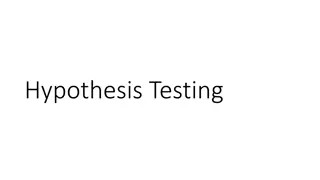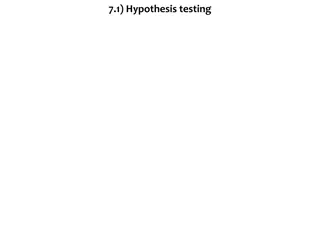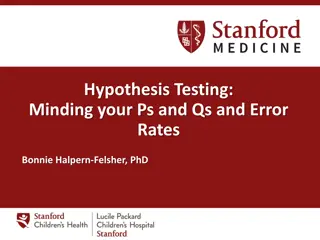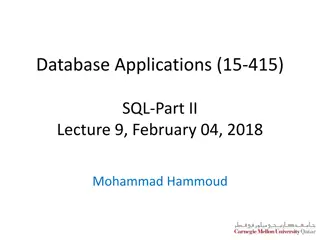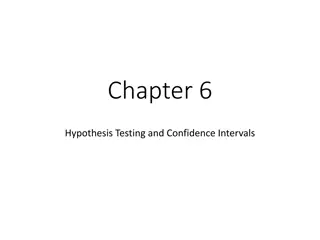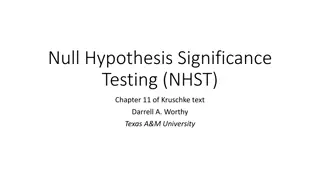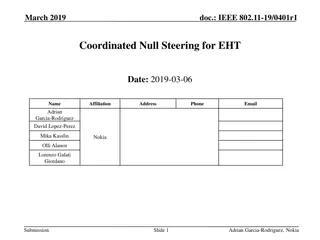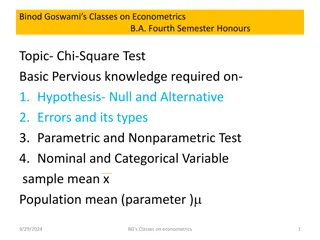
Understanding Male Infertility: Causes, Diagnosis, and Management
Explore the various causes of male infertility, including congenital and acquired factors, and learn about the importance of examining both partners simultaneously in infertility evaluations. Discover prognostic factors that can impact fertility outcomes and delve into the details of semen analysis parameters. Gain insights into the complexities of male subfertility and the significance of early diagnosis and proper management in addressing infertility issues.
Download Presentation

Please find below an Image/Link to download the presentation.
The content on the website is provided AS IS for your information and personal use only. It may not be sold, licensed, or shared on other websites without obtaining consent from the author. If you encounter any issues during the download, it is possible that the publisher has removed the file from their server.
You are allowed to download the files provided on this website for personal or commercial use, subject to the condition that they are used lawfully. All files are the property of their respective owners.
The content on the website is provided AS IS for your information and personal use only. It may not be sold, licensed, or shared on other websites without obtaining consent from the author.
E N D
Presentation Transcript
BY DR:Mohamed kadry
Definition Infertility is the inability of a sexually active, non- contracepting couple to achieve spontaneous pregnancy in one year , World Health Organization (WHO About 15% of couples do not achieve pregnancy within one year and seek medical treatment for infertility
Atieology congenital or acquired urogenital abnormalities; Malignancies; Urogenital tract infections; Increased scrotal temperature (e.g. as a consequence of varicocele); Endocrine disturbances; Genetic abnormalities; Immunological factors Idiopathic infertility in 30-40 %
Maldescended testes Varicocele Sperm autoantibodies Testicular tumour Idiopathic infertility Klinefelter s syndrome (47, XXY) XX male Primary hypogonadism of unknown cause Secondary (hypogonadotropic) hypogonadism Kallmann syndrome
C C Investigate both partners simultaneously, to categorise infertility Include the fertility status of the female partner in the diagnosis and management of male subfertility because this might determine the final outcome B B C C Examine all men diagnosed with fertility problems, including men with abnormal semen parameters for urogenital abnormalities
Prognostic factors Duration of infertility; Primary or secondary infertility; Results of semen analysis; Age and fertility status of female partner
Semen analysis Semen volume (mL) Semen analysis 1.5 (1.4-1.7) Total sperm number (106/ejaculate) 39 (33-46) Sperm concentration (106/mL) 15 (12-16) Total motility (PR + NP) 40 (38-42) Progressive motility (PR%) 32 (31-34) Vitality (live spermatozoa, %) 58 (55-63) Sperm morphology (normal forms 4 (3.0-4.0) pH Peroxidase-positive leukocytes (106/mL) > 7.2 < 1.0
Optional investigations MAR(mixed anti globulin reaction) test (motile spermatozoa with bound particles, %) < 50 Immuno bead test (motile spermatozoa with bound beads, %) < 50 Seminal zinc ( mol/ejaculate) > 2.4 Seminal fructose ( mol/ejaculate) > 13 Seminal neutral glucosidase (mU/ejaculate) Oligozoospermia: < 15 million spermatozoa/mL; Asthenozoospermia: < 32% progressive motile spermatozoa; Teratozoospermia: < 4% normal forms.
Perform semen analyses according to the guidelines of the WHO Laboratory Manual for the Examination and Processing of Human Semen ( Perform further andrological assessment when semen analysis is abnormal in at least two tests. Perform semen analyses according to the guidelines of the WHO Laboratory Manual for the Examination and Processing of Human Semen (5 5th A A th edn edn) ) A
CONDITIONS CAUSING MALE INFERTILITY
Primary Spermatogenic Failure Causes Congenital 1- Anorchia 2- Testicular dysgenesis/cryptorchidism 3- Genetic abnormalities (karyotype, Y-chromosome deletions) Acquired Trauma Testicular torsion Post-inflammatory forms, particularly mumps orchitis Exogenous factors (medications, cytotoxic or anabolic drugs, irradiation, heat) Systemic diseases (liver cirrhosis, renal failure) Testicular tumour Varicocele Idiopathic
Semen analysis In non-obstructive azoospermia (NOA), semen analysis shows normal ejaculate volume and azoospermia after centrifugation. Hormonal In men with testicular deficiency, Hypergonadotropic hypogonadism is usually present, with high levels of follicle-stimulating hormone (FSH) and luteinising hormone (LH), and sometimes low levels of testosterone Ultrasonography :to exclude OAS ,signs of testiculer dysgenesis
Testicular biopsy Testicular biopsy can be part of intracytoplasmic sperm injection (ICSI) treatment in patients with clinical evidence of NOA. Testicular sperm extraction (TESE) is the technique of choice. Spermatogenesis may be focal, which means that in about 50% of men with NOA, spermatozoa can be found and used for ICSI. There is a good correlation between the histology found upon diagnostic biopsy and the likelihood of finding mature sperm cells during testicular sperm retrieval and ICSI.
A A For men who are candidates for sperm retrieval, give appropriate genetic counselling even when testing for genetic abnormalities was negative In men with non-obstructive azoospermia (NOA), perform simultaneous testicular biopsy with multiple testicular sperm extraction (TESE) (or micro- TESE) to define spermatogenesis and diagnose intratubular germ cell neoplasma of unclassified type (ITGCNU) and eventually kryopreservation of sperm. A
Genetic disorders in infertility Chromosomal abnormalities Chromosome abnormalities can be numerical (e.g. trisomy) or structural (e.g. inversions or translocations). Sex chromosome abnormalities (Klinefelter s syndrome and variants [47,XXY; 46,XY/47, XXY mosaicism]) Klinefelter s syndrome is the most common sex chromosome abnormality. Adult men with Klinefelter s syndrome have small firm testicles, devoid of germ cells
The phenotype varies from a normally virilised man to one with the stigmata of androgen deficiency, including female hair distribution, scant body hair, and long arms and legs due to late epiphyseal closure. Leydig cell function is commonly impaired in men with Klinefelter s syndrome . Testosterone levels may be normal or low, oestradiol levels normal or elevated, and FSH levels increased. Libido is often normal despite low testosterone levels Germ cell presence and sperm production are variable in men with Klinefelter s mosaicism, 46,XY/47,XXY.
Kallmann syndrome Patients with Kallmann syndrome have hypogonadotropic hypogonadism and anosmia, but may also have other clinical features, including facial asymmetry, cleft palate, colour blindness, deafness, maldescended testes, and unilateral renal aplasia. Spermatogenesis can be relatively easily induced by hormonal treatment
Mild androgen insensitivity syndrome The Androgen Receptor (AR) gene is located on the long arm of the X-chromosome. Mutations in the AR gene may result in mild to complete androgen insensitivity. The phenotypic features of complete androgen insensitivity syndrome are female external genitalia and absence of pubic hair (Morris syndrome). In partial androgen insensitivity syndrome, phenotypes range from predominantly female phenotype through ambiguous genitalia, to predominantly male phenotype with micropenis, perineal hypospadias, and cryptorchidism
Y-chromosome and male infertility Microdeletions on the Y-chromosome are termed AZFa, AZFb and AZFc Clinical implications of Y microdeletions They are not found in normozoospermic men The highest frequency of Y-deletions is found in azoospermic men (8-12%), followed by oligozoospermic (3-7%) men. Deletions are extremely rare with a sperm concentration > 5 million/mL (~0.7%). AZFc deletions are most common (65-70%), followed by Y-deletions of the AZFb and AZFb+c or AZFa+b+c regions (25-30%). AZFa region deletions are rare (5%).
Complete removal of the AZFa region is associated with severe testicular phenotype (Sertoli cell only syndrome), while complete removal of the AZFb region is associated with spermatogenic rest. Complete removal of the AZFc region causes a variable phenotype ranging from azoospermia to oligozoospermia. Classical (complete) AZF deletions do not confer a risk for cryptorchidism or testicular cancer
Cystic fibrosis mutations and male infertility Cystic fibrosis (CF) is a fatal autosomal-recessive disorder. It is the most common genetic disease of Caucasians; 4% are carriers of gene mutations involving the CF transmembrane conductance regulator(CFTR) gene located on chromosome 7p. It encodes a membrane protein that functions as an ion channel and influences the formation of the ejaculatory duct, seminal vesicle, vas deferens and distal two-thirds of the epididymis. Congenital bilateral absence of the vas deferens (CBAVD) is associated with CFTR gene mutations
B Obtain standard karyotype analysis in all men with damaged spermatogenesis (spermatozoa< 10 million/mL) who are seeking fertility treatment by in vitro fertilisation (IVF) Provide genetic counselling in all couples with a genetic abnormality found in clinical or genetic investigation and in patients who carry a (potential) inheritable disease For all men with Klinefelter s syndrome, provide long-term endocrine follow-up and androgen replacement therapy, if necessary A A A
A A Do not test for microdeletions in men with obstructive azoospermia (OA) when intracytoplasmic sperm injection (ICSI) is used because spermatogenesis should be normal Inform men with Yq microdeletion and their partners who wish to proceed with intracytoplasmic sperm injection (ICSI) that microdeletions will be passed to sons, but not to daughters In men with structural abnormalities of the vas deferens (unilateral or bilateral absence), test the man and his partner for cystic fibrosis transmembrane conductance regulator (CFTR) gene mutations. A A
Obstructive azoospermia Obstructive azoospermia (OA) is the absence of spermatozoa and spermatogenetic cells in semen and post-ejaculate urine due to obstruction. Classification Intratesticular obstruction Intratesticular obstruction occurs in 15% of men with OA. Congenital forms are less common than aquired forms (post- inflammatory or post-trauma Epididymal obstruction Epididymal obstruction is the most common cause of OA, affecting 30-67% of azoospermic men Congenital epididymal obstruction usually manifests as CBAVD, s (Young s syndrome)]. Acquired forms secondary to acute (e.g., gonococcal) and subclinical (e.g., chlamydial) epididymitis are most common
Vas deferens obstruction Vas deferens obstruction is the most common cause of acquired obstruction following hernia repair or congenital vasal obstruction is CBAVD, often accompanied by CF. Ejaculatory duct obstruction Ejaculatory duct obstruction is found in 1-3% of cases of OA and is classified as either cystic or postinflammatory. Cystic obstructions are usually congenital It diagnosed by : low semen volume, decreased or absent seminal fructose, and acid pH. The seminal vesicles are usually dilated (anterior-posterior diameter > 15 mm)
Diagnosis Clinical history Clinical examination Clinical examination should follow suggestions for the diagnostic evaluation of infertile men. OA is indicated by at least one testis with a volume > 15 mL Semen analysis At least two examinations must be carried out at an interval of two to three months, according to the WHO). Hormone levels Serum FSH levels should be normal Testicular biopsy In selected cases, testicular biopsy is indicated to exclude spermatogenic failure..
Intratesticular obstruction Only TESE allows sperm retrieval in these patients and is therefore recommended. Epididymal obstruction Microsurgical epididymal sperm aspiration (MESA) is indicated in men with CBAVD. In patients with azoospermia due to acquired epididymal obstruction, microsurgical reconstruction is recommended Proximal vas deferens obstruction Proximal vas deferens obstruction after vasectomy requires microsurgical vasectomy reversal or Microsurgical tubulovasostomy if epidydmis is obstructed Distal vas deferens obstruction TESE MESA or proximal vas deferens sperm aspiration can be used for cryopreservation for future ICSI.
Ejaculatory duct obstruction The treatment of ejaculatory duct obstruction depends on its aetiology. Transurethral resection of the ejaculatory ducts (TURED Complications Retrograde ejaculation due to bladder neck injury and urine reflux into the ejaculatory ducts, seminal vesicles, and vasa. The alternatives to TURED are MESA, TESE, proximal vas deferens sperm aspiration, seminal vesicle ultrasonically guided aspiration, and direct cyst aspiration.].
Perform microsurgical vasovasostomy or tubulovasostomy for azoospermia caused by vasal or epididymal obstruction B Use sperm retrieval techniques, such as microsurgical epididymal sperm aspiration (MESA), testicular sperm extraction (TESE) and percutaneous epididymal sperm aspiration (PESA) only when cryostorage of the material obtained is available B
Varicocele Varicocele is a common abnormality which may be associated with the following andrological conditions: Failure of ipsilateral testicular growth and development, Symptoms of pain and discomfort, Male subfertility, Hypogonadism. Classification Subclinical: not palpable or visible at rest or during Valsava manoeuvre, but can be shown by special tests (Doppler ultrasound studies) Grade 1: palpable during Valsava manoeuvre, Grade 2: palpable at rest, but not visible, Grade 3: visible and palpable at rest.
Diagnostic evaluation The diagnosis of varicocele is made by clinical examination and should be confirmed by US investigation and colour Duplex Varicocele and fertility Varicocele is a physical abnormality present in 11.7% of adult men and in 25.4% of men with abnormal semen. The exact association between reduced male fertility and varicocele is unknown .
In clinical varicoceles surgical varicocelctomy significantly improves semen parameters in men with abnormal semen parameters including men with non- obstructive azoospermia subclinical varicocelectomy was found to be ineffective in increasing the chance of spontaneous pregnancies Prophylactic varicocelectomy: treatment is only advised in case of documented growth deterioration of the testis as documented by serial clinical examinations and impaired semen quality
B B Treat varicoceles in adolescents with progressive failure of testicular development documented by serial clinical examination A Do not treat varicoceles in infertile men who have normal semen analysis and in men with a subclinical varicocele. A Treat varicoceles in men with a clinical varicocele, oligospermia and otherwise unexplained infertility in the couple
Hypogonadism Hypogonadism is characterised by impaired testicular function, which may affect spermatogenesis and/or testosterone synthesis. The symptoms of hypogonadism depend on the degree of androgen deficiency and if the condition develops before or after pubertal development of the secondary sex characteristics. Aetiology Primary (hypergonadotropic) hypogonadism due to testicular failure Secondary (hypogonadotropic) hypogonadism caused by insufficient gonadotropin-releasing hormone (GnRH) and/or gonadotropin (FSH, LH) secretion. Androgen insensitivity (end-organ resistance)
A A Provide testosterone replacement therapy for symptomatic patients with primary and secondary hypogonadism who are not considering parenthood A In men with hypogonadotropic hypogonadism, induce spermatogenesis by an effective drug therapy (human chorionic gonadotropin( hCG), human menopausal gonadotropins (hMG), recombinant folliclestimulating hormone (rFSH) Do not use testosterone replacement for the treatment of male infertility A
Cryptorchidism Cryptorchidism is the most common congenital abnormality of the male genitalia, at one year of age nearly 1% of all full-term male infants have cryptorchidism Aetiology and pathophysiology It has been postulated that cryptorchidism may be a part of the so- called testicular dysgenesis syndrome (TDS), which is a developmental disorder of the gonads caused by environmental and/or genetic influencesearly in pregnancy. TDS (cryptorchidism, hypospadias, and Leydig cell dysfunction).
Pathophysiological effects in maldescended testes Degeneration of germ cells The degeneration of germ cells in maldescended testes is apparent after the first year of life and varies, depending on the position of the testis Early treatment is therefore recommended (after the age of six months surgery should be performed within the subsequent year with age eighteen months the latest) to conserve spermatogenesis and hormone production, as well as to decrease the risk for tumours.
Surgical treatment is the most effective. Medical treatment with GnRH may be beneficial Relationship with fertility Semen parameters are often impaired in men with a history of cryptorchidism men with bilateral cryptorchidism, oligozoospermia can be found in 31% and azoospermia in 42%. In cases of bilateral cryptorchidism, the rate of paternity is only 35-53%
Germ cell tumours As a component of the Testicular Dysgenesis Syndrome cryptorchidism is a risk factor for testicular cancer and is associated with testicular microcalcification and intratubular germ cell neoplasia of unclassified type (ITGCNU Orchidopexy performed before the age of puberty has been reported to decrease the risk of testicular cancer
Disease management Hormonal treatment Human chorionic gonadotropin or GnRH is not recommended for the treatment of cryptorchidism in adulthood. Surgical treatment In adolescence removal of intra-abdominal testis (with a normal contralateral testis) can be recommended, because of the theoretical risk of later malignancy. In adulthood, a palpable undescended testis should not be removed because it still produces testosterone.
correction of bilateral cryptorchidism, even in adulthood, can lead to sperm production in previously azoospermic men. At the time of orchidopexy, performed in adulthood, testicular biopsy for detection of ITGCNU is recommended. At the time of orchiectomy in the treatment of germ cell tumours biopsy of the contralateral testis should be offered to patients at high risk for ITGCNU (i.e. history of cryptorchidism, < 12 ml. testicular volume, poor spermatogenesis
A A Do not use hormonal treatment of cryptorchidism in adults B If undescended testes are corrected in adulthood, perform simultaneous testicular biopsy for detection of intratubular germ cell neoplasia of unclassified type (ITGCNU) (formerly carcinoma in situ (CIS)).
Idiopathic male infertility No demonstrable cause of infertility is found in at least 44% of infertile men. Disease management Empirical treatments Clomiphen citrate and tamoxifen have been widely used in idiopathic infertility and show some improvement in sperm quality and spontaneous pregnancy rates
Androgens, bromocriptine, -blockers, systemic corticosteroids and magnesium supplementation are not effective in the treatment of idiopathic male infertility Gonadotrophins (HMG/rFSH) might be beneficial in regards to pregnancy rates and live birth in idiopathic male factor subfertility Men taking oral antioxidants had an associated significant increase in sperm parameters
A A Medically treat male infertility only for cases of hypogonadotropic hypogonadism B No clear recommendation can be made for treatment with gonadotropins, anti-oestrogens and antioxidants even for a subset of patients
Male accessory gland infections and infertility Infections of the male urogenital tract are potentially curable causes of male infertility. The WHO considers urethritis, prostatitis, orchitis and epididymitis to be male accessory gland infections However, specific data are not available to confirm that these diseases have a negative influence on sperm quality and male fertility .




